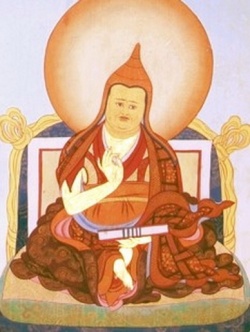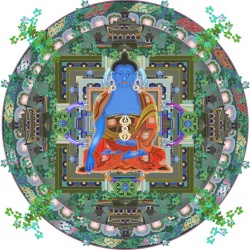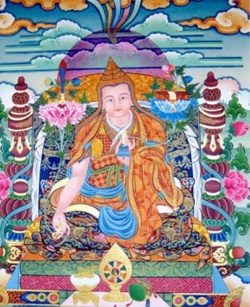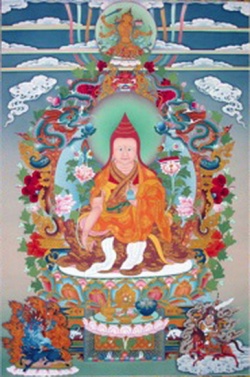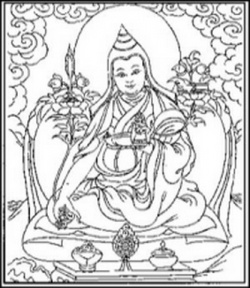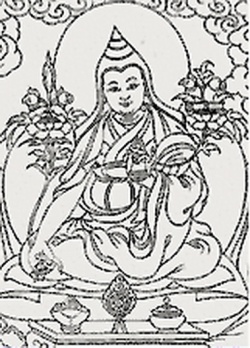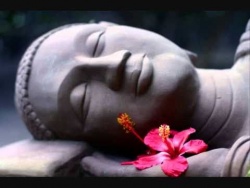Jamgon Ju Mipham Gyatso
Jamgön Ju Mipham, or Mipham Jamyang Namgyal Gyamtso , Jamgon Ju Mipham Gyatso (mi pham 'jam dbyangs rnam rgyal) (1846–1912) (also known as "Mipham the Great") was a master of the Nyingma lineage of Tibetan Buddhism and one of the leading figures in the Rime (non-sectarian) movement in Tibet.
Derivation of name
"Ju" ("holding") was Mipham's family name as his paternal clan is said to have originated as clear light deities who came to the human world holding a rope.
"Jamgön" or "Jamyang" indicates that he was considered to be an emanation of the bodhisattva Mañjuśrī. His maternal uncle, Minister-Lama Drupchok Pema Tarjay, named him Mipham Gyamtso ("Invincible Ocean" or "Unconquerable Ocean").
Ju Mipham (1846-1912) ranks alongside Longchen Rabjam and Tsongkhapa as one of Tibet’s most prolific and influential masters.
His presentation of the Nyingma School’s unique approach to the view and practice of Buddhism, and in particular the relationship between Madhyamaka and the Great Perfection, has had an enormous impact on the past few generations of Tibetan Buddhist scholars and practitioners.
Namdrolling Monastic College, currently the largest functioning Nyingma educational institution, includes twenty of his texts in its curriculum.
By comparison, only five texts by Longchenpa are included and only one by Rongzom Pandita.
Mipham’s primary teachers were Patrül Rinpoche and Jamyang Khyentsé Wangpo, both incarnations of the tertön Jigmé Lingpa.
Khyentsé Rinpoche requested Mipham to preserve the Nyingma teachings through teaching, debate, and composition—a task in which he admirably succeeded.
About his remarkable student, Khyentsé remarked: “In this time, there is no one else on earth more learned than Lama Mipham.”
He excelled not only in study and teaching, however, but in practice as well.
The numerous retreats he completed were always accompanied by miraculous signs of accomplishment.
Mipham Rinpoche’s collected writings comprise twenty-seven volumes and cover a vast array of topics.
Among his most influential writings are The Speech of Delight—a commentary on Shantarakshita’s Ornament of the Middle Way, Gateway to Knowledge—which provides an overview of the Buddha’s teachings, and Beacon of Certainty—an elucidation of the view of the Great Perfection and its relationship to the Middle Way teachings.
Biography
Early life
Mipham the Great was born to an aristocratic family in 1846 in the Derge Principality of Kham or Eastern Tibet.
He was recognized as an exceptional child from a young age, memorizing texts as early as age six. By the age of ten he had already composed many texts.
At twelve, he entered the monastery as an ordinary monk of the Ogmin Urgyen Mindrolling lineage at a branch monastery of the great Nyingma seat Shechen.
When he was fifteen or sixteen, after studying the very difficult Mindrolling system of chanting for only a few days and praying to Manjushri, he is said to have completely mastered it.
In an 18-month retreat he accomplished the form of Manjushri known as 'Lion of Philosophers' (Tibetan: smra ba'i seng ge), using a liturgy composed by the fifteenth Karmapa, Khakhyab Dorje.
He made many medicinal pills blessed with Manjushri's mantra, and many miraculous signs were said to have been manifest.
After this, it was said that he could accomplish any sutra or tantra without any effort, and no text was unknown to him. He went to many lamas to obtain the necessary lungs (oral transmissions), but he needed no study or teachings for any texts.
Teachers
Mipham was "a luminary of the nineteenth century Nyingma renaissance and Rime movement ecumenical movement, which started in the Kham region of eastern Tibet".
As such he received teachings from masters of all lineages Nyingma and Sarma alike.
His root gurus were Dza Patrul Rinpoche, from whom he received instruction on Shantideva's Bodhicharyavatara and Dzogchen and the renowned master Jamyang Khyentse Wangpo, from whom he received transmission of the orally transmitted or Kama and revealed or Terma lineages, and many other teachings.
His other teachers included Jamgon Kongtrul Lodro Thaye; Dzogchen Khenpo Padma Vajra; Lab Kyabgon Wangchen Gyerab Dorje; Jubon Jigme Dorje; Bumsar Geshe Ngawang Jungne and Ngor Ponlop Jamyang Loter Wangpo.
Work and legacy
As scholar Robet Mayer remarks, Mipham "completely revolutionised rNying ma pa scholasticism in the late 19th century, raising its status after many centuries as a comparative intellectual backwater, to arguably the most dynamic and expansive of philosophical traditions in all of Tibetan Buddhism, with an influence and impact far beyond the rNying ma pa themselves."
Scope
In the Introduction to his critical study of the ontological debates between Mipham and his Gelugpa opponents (Mipham's Dialectics and the Debates on Emptiness) Lopon Karma Phuntsho defines Mipham as a polymath and gives this assessment of the scope of Mipham's work:
- Mipham is perhaps the greatest polymath Tibet ever produced. His writings comprise works on a wide range of subjects, covering almost every science known to his milieu.
In traditional terms he is a Mahāpaṇḍita who has mastered the ten sciences of arts and crafts (bzo), health science (gso ba), language (sgra), logico-epistemology (tshad-ma), soteriology (nang don), poetry (snyan ngag), lexicology (mngon brjod), prosody (sdeb sbyor), dramaturgy (zlos gar), and astrology (dkar rtsis).
It is due to the polymathic nature of his learning and his exceptional ingenuity that Mipham today ranks amongst the leading religious and spiritual celebrities of Tibet
Mipham's works on both the exoteric or Sutrayana teachings and the esoteric or Vajrayāna teachings have become core texts within the Nyingma tradition.
These works now hold a central position in the curriculum of all Nyingma monasteries and monastic colleges — occupying a place of esteem similar the works of Sakya Pandita and Gorampa in the Sakya tradition; those of Tsongkhapa in the Gelug tradition and of Kunkhyen Padma Karpo in the Drukpa Kagyu.
Together with Rongzompa and Longchenpa, Mipham is considered to be one of the three "omnscient" writers of the Nyingma tradition. Commentaries on Buddhist Śāstra
Although Mipham wrote on a wide range of subjects, Prof. David Germano identifies the most influential aspect of Mipham's career in that he "was the single most important author in the efflorescence of Nyingma exoteric literature in the nineteenth and twentieth centuries.
Grounding himself theoretically in the writings of Longchenpa and other great Nyingma authors, Mipham produced brilliant exegetical commentaries on the great Indian philosophical systems and texts with a Nyingma orientation.".
E. Gene Smith also judged that Mipham's greatest contribution was "in his brilliant and strikingly original commentaries on the Indian treatises."
Prior to Mipham, Nyingmapa scholars "had seldom written detailed pedagogical commentaries on the śāstras of exoteric Buddhism.
" Until his time the colleges or shedra associated with the great Nyingma monasteries of Kham, such as Dzogchen, Shechen, Kathog, Palyul and Tarthang lacked their own exegetical commentaries on these exoteric Mahayana śāstras, and students commonly studied Gelug commentaries on these fundamental texts.
Grounding himself in the writings of Śāntarakṣita, Rongzom Chokyi Zangpo, and Longchenpa, Mipham produced a whole array of brilliant exegetical commentaries on the great Indian philosophical systems and texts that clearly articulated a Nyingma orientation or view.
The texts include his commentaries on the Mulamadhyamakakarika or Fundamental Stanzas on Wisdom by Nagarjuna; the Introduction to the Middle Way (Sanskrit: Madhyamakāvatāra) of Chandrakirti; the Quintessence of all Courses of Ultimate Wisdom (Jnanasarasamuccaya) of Aryadeva; commentaries on the major works of the Indian Buddhist logicians Dharmakirti and Dignaga; commentaries on the Five Treatises of Maitreya most notably, the Abhisamayalamkara; commentaries on several works of Vasubandhu including the Abhidharmakosha.
Miphams commentary on the ninth chapter of Shantideva's Bodhicaryavatara, the Shertik Norbu Ketaka (Tibetan: ཤེར་ཊཱིཀ་ནོར་བུ་ཀེ་ཏ་ཀ, Wylie: sher ṭīk nor bu ke ta ka),[8] "threw Tibetan scholarly circles into several decades of heated controversy," but "it was not the only tempest Mipham's new expositions raised." His commentary on the Madhyamakalamkara of Śāntarakṣita was also considered highly controversial.
Vajrayana works
Mañjuśrī
As a scholar and meditator Mipham was so accomplished that he was enthroned as an emanation of Manjushri, the bodhisattva of wisdom.
Most of the Fifth volume of his collected works consists of works related to Manjusri.
Guhyagarbha Tantra
Mipham's commentary on the Guhyagarbha Tantra is entitled The Essence of Clear Light or Nucleus of Inner Radiance (Wylie: od gsal snying po)— it is based on Longchenpa's commentary, Dispelling Darkness in the Ten Directions Wylie: gsang snying 'grel pa phyogs bcu mun sel which explains the Guhyagarbha from the Dzogchen point of view.
Kalacakra
Mipham showed particular interest in the Kalachakra and the kingdom of Shambhala, and one of his last and most extensive of his esoteric works are his two volumes of commentary, initiation and sadhana related to the Kalachakra Tantra, the esoteric teaching from Shambhala. Before he died in 1912, he said to his students that now he was going to Shambhala.
Dzogchen
It may appear that Mipham did not write extensively on Dzogchen (The Great Perfection) however there are many references to it throughout his original compositions.
One volume of his writings comprises short, pithy instructions on the view, meditation and practice (or Action) of Great Perfection.
Volume 24 contains his commentary on Jigme Lingpa's Yonten Dzöd and a three-part original exposition of Great Perfection, the Trilogy of Fundamental Mind.
Only some parts of the first section of this may be by Mipham Rinpoche's own hand.
Much or all of that section, as well as second and third are based on notes and recollections of Mipham's closest disciple, Shechen Gyaltsab, who in turn was one of the principle teachers of the late Dilgo Khyentse Rinpoche.
Mipham Rinpoche regretted the incompleteness of the Trilogy but nevertheless it is a mine of profound commentary on Great Perfection, especially in defending those teachings against its critics, and clearing up misconceptions and misinterpretations of Dzogchen, such as confusing it with certain aspects of teachings of the New Tantras as was common in Mipham's day.
Besides his texts explicitly concerned with Dzogchen, many of Mipham Rinpoche's other works are written with Dzogchen in mind—if not as the subject, then as an overriding theme.
Among those are the "Five Lotuses" and "Five Swords", short and intermediate-length commentaries on the essence of wisdom and language;
the Beacon of Certainty which is perhaps the most essential of Mipham's original writings; and in many of Mipham's liturgies (such as those of Gesar), his essays of practical advice (gtams-tshogs), his verses of praise to Manjushri,
Sarasvati and other persons, historical or otherwise (bstod-tshogs), and in one of his most famous compositions which is an 'aspiration' (smon-lam), Mipham makes clear—either explicitly or using coded language—the centrality of Dzogchen/Great Perfection to his view, meditation, practice and experiential realization.
Mipham and Gesar
Throughout his life, Mipham showed a particular interest in the legend of the warrior king Gesar of Ling, a 12th century figure whose epic is well-known and widely celebrated in eastern Tibet, and about whom Mipham wrote extensively.
The Gesar practice, known as "The Swift Accomplishment of Enlightened Activity Through Invocation and Offering" (Wylie:
gsol mchod phrin las myur 'grub) arose in the mind of Mipham as a gong-ter and was written down over the course of 3 years from the age of 31 to 34. This practice invokes Gesar and his retinue and requests him to assist practitioners.
Medicine
Mipham's medical works continue to be highly regarded to this day
Astrology and divination
Mipham also wrote extensively about astrology which was, in his words, a "delightful game" that he mastered in his teens but later applied to more serious topics such as medicine; these two topics, with various texts on more or less related topics of divination, occupy perhaps 2,000 pages of his writing.
An entire volume of Mipham's is devoted to Ju-thig or divination using knots, a method that might be termed "Bon" in origin, for want of a more accurate term; this may have been the legacy of his family, who were doctors for several generations.
Throughout his writings there are many resources for divination, in addition to astrology, including several rituals for looking in mirrors (pra-mo), one using dice (mo), pulling different-length 'arrows' (Wylie:
da dar) out of a quiver and so on, compelling a non-human "bird" to whisper future news in one's ear, and so on.
In one short text he prescribes various methods of divination (all drawn, Mipham emphasizes, from Tantric scriptures and commentaries) that make use of unusual sources of augury such as: the vicariously overheard chatter of women; sudden appearance of various animals, especially birds; weather phenomena; the shape, size and color of flames in the agnihotra or fire puja;
the quality of burning butter lamps, especially the size of the flame, the amount and shape of smoke that arises; and the size and shape of the carbon deposit on the wick.
When some of his scholarly rivals thought it inappropriate for a monk to devote so much time to matters of future events, Mipham wrote a short essay explaining the purpose of divination, citing sources in the Sutras and Tantras where the utility and value of divination are explained.
Students
Mipham’s most important students were. Dodrub Rinpoche, Terton Sogyal, the Fifth Dzogchen Rinpoche, Gemang Kyab Gon, Khenpo Padmavajra, Katog Situ Rinpoche, Sechen Rabjam, Gyaltsab Tulku, Palyul Gyaltrul, Karma Yangtrul, Palpung Situ Rinpoche, Ling Jetrung, Adzom Drukpa (1842-1924), Tokden Shakya Shri, Ngor Ponlob, and others.
The great tulkus of Sechen, Dzogchen, Katog, Palyul, Palpung, Dege Gonchen, Repkong and others of all lineages, Sakya, Gelug, Kagyu, and Nyingma, all became his disciples.
Emanations of Ju Mipham
According to one account shortly before he died, Mipham told his attendant:
- Nowadays, if you speak the truth, there is nobody to listen; if you speak lies everyone thinks it is true.
I have never said this before:
I am not an ordinary person;
I am a bodhisattva who has taken rebirth through aspiration.
The suffering experienced in this body is just the residue of karma; but from now on I will never again have to experience karmic obscuration. …
Now, in this final age, the barbarians beyond the frontier are close to undermining the teaching.
[So] there is no point whatsoever in my taking rebirth here…I have no reason to take birth in impure realms ever again.
This may be interpreted as a statement that his mindstream would have no further 'emanations' (Wylie: sprul pa (tulpa); sprul sku (tulku)).
Conversely, according to another account in which he mentions the mindstream in passing and prophesies the shortly before his death to his student Khenpo Kunphel:
- Now I shall not remain long in this body. After my death, in a couple of years hence, war and darkness shall cover the earth, which will have its effect even on this isolated snow land of Tibet. In thirty years time, a mad (smyo) storm of hatred will grow like a fierce black thundercloud in the land of China, and in a further decade this evil shall spill over into Tibet itself, so that Lamas, scholars, disciples and yogis will come under terrible persecution.
Due to the demon-king Pehar taking power in China, darkness and terror ('bog) will come to our sacred land, with the result that violent death shall spread like a plague through every village. Then the three lords of materialism (gsum-gyi-kla-klos) and their cousins will seize power in Tibet, spreading war, famine and oppression.
No one will be safe. Now, very soon, my mind-stream will be gathered up in the pure-land of Tusita, from whence many emanations [of myself] shall then come forth in future years.
I shall not take rebirth in Tibet. In twenty years, seek me in the northern lands of distant Uttarakuru, and elsewhere, east, west, north and south. Fear not, we shall be re-united again, as father and son. Now go!
In the above account, shortly after the departure of Khenpo Kunphel he stated publicly, "Now, soon I shall depart. I shall not be reborn again in Tibet, therefore do not search for me. I have reason to go to Shambhala in the north."
Subsequently a number of emanations have been recognized.
According to E. Gene Smith "At least three rebirths were recognized in the decade following his death:
1) Zhe chen Mi pham (a grandnephew of Mi pham rgya mtsho);
2) Tshe dbang bdud 'dul (1915/16-42) the last prince of Sde dge;
3. Khyung po Mi pham, an incarnation recognized by Rdzong gsar Mkhyen brtse '[[Jam dbyangs chos kyi blo gros]]."
The next (third) Mipham in the line of the Dege Prince who died in 1942 was apparently born in Tibet in 1949 and recognised by Tengye Rinpoche of Lab i 1959 At that time he was enthroned and given responsibility for all monasteries previously held by the first and second incarnations.
This third incarnation was also confirmed by Patrul Rinpoche who gave him relics of the previous incarnations and by Dilgo Khyentse Rinpoche, who he had recognized in a previous incarnation.
This Mipham incarnate is the father of Thaye Dorje, one of two candidates to be recognized as the 17th Karmapa, and of 14th Sonam Tsemo Rinpoche, an important Gelug/Sakya tulku.
In 1995, Ösel Rangdröl Mukpo (b. 1962), the eldest son of renowned dharma master Chogyam Trungpa Rinpoche and Ani Könchok Palden, was recognized as a reincarnation of Mipham Rinpoche by HH Drubwang Padma Norbu Rinpoche, at the time the head of the Nyingma lineage.
He is now known as Sakyong Mipham Rinpoche, and is the spiritual head of Shambhala International.
Alternate names
- Jamgon Ju Mipham Gyatso (ʼJam-mgon ʼJu Mi-pham rgya-mtsho)
- Jamgön Mipham (ʼJam-mgon Mi-pham)
- Ju Mipham (ʼJu Mi-pham)
- Mipham Gyatso (mi pham rgya mtsho)
- Ju Mipham Namgyal Gyatso (ʼju mi pham rnam rgyal rgya mtsho)
- Mipham Namgyal Gyatso (mi pham rnam rgyal rgya mtsho)
- Jamgon Mipham Gyatso (ʼjam mgon mi pham rgya mtsho)
Works of Jamgon Ju Mipham Gyatso translated into English
- Kunsang, Erik Pema (trans.) Gateway to Knowledge. Rangjung Yeshe Publications.
- Vol 1 (1997)
- Vol 2 (2002)
- Vol 3 (2002)
- Vol 4 (Forthcoming)
- Dharmachakra Translation Committee (trans.) Ju Mipham, Middle Beyond Extremes: Maitreya's Madhyantavibhaga with Commentaries by Khenpo Shenga and Ju Mipham. Snow Lion Publications (2007)
- Doctor, Thomas H. (trans.) Speech of Delight: Mipham's Commentary of Shantarakshita's Ornament of the Middle Way. Ithaca: Snow Lion Publications (2004)
- Padmakara Translation Group (trans.) Shantarakshita & Jamgon Mipham The Adornment Of The Middle Way. Shambhala Publications (June 2005)
- Padmakara Translation Group (trans.) Introduction to the Middle Way: Chandrakirti's Madhyamakavatara with Commentary by Jamgön Mipham. Shambhala Publications 2002
- Padmakara Translation Group (trans.) White Lotus: An Explanation of the Seven-line Prayer to Guru Padmasambhava by Jamgön Mipham. Shambhala Publications (2008)
- Petit, John Whitney. Mipham's Beacon of Certainty: Illuminating the View of Dzochen, the Great Perfection. Boston: Wisdom Publications (1999)
- Tulku, Tarthang (translator) Calm and Clear by Lama Mipham. Emeryville, CA: Dharma Publishing (1973)(illustrations by Arthur Okamura)
- Hopkins, Jeffery (trans. & ed.) Fundamental Mind: The Nyingma View of the Great Completeness by Mi-pam-gya-tso, comm. by Khetsun Sangpo Rinbochay. Snow Lion Publications (2006) ISBN 1-55939-250-9
- Rinpoche, Thrangu. Middle-way Meditation Instructions of Mipham Rinpoche. Namo Buddha Publications (2001)
- Scott, J. Maitreya's Distinguishing Phenomena and Pure Being with Commentary by Mipham. Snow Lion Publications
- Yeshe Gyamtso Garland of Jewels: The Eight Great Bodhisattvas. KTD Publications
Translations available online
- Lotsawa House - Mipham Rinpoche Series - Translations of several texts by Mipham Rinpoche.
